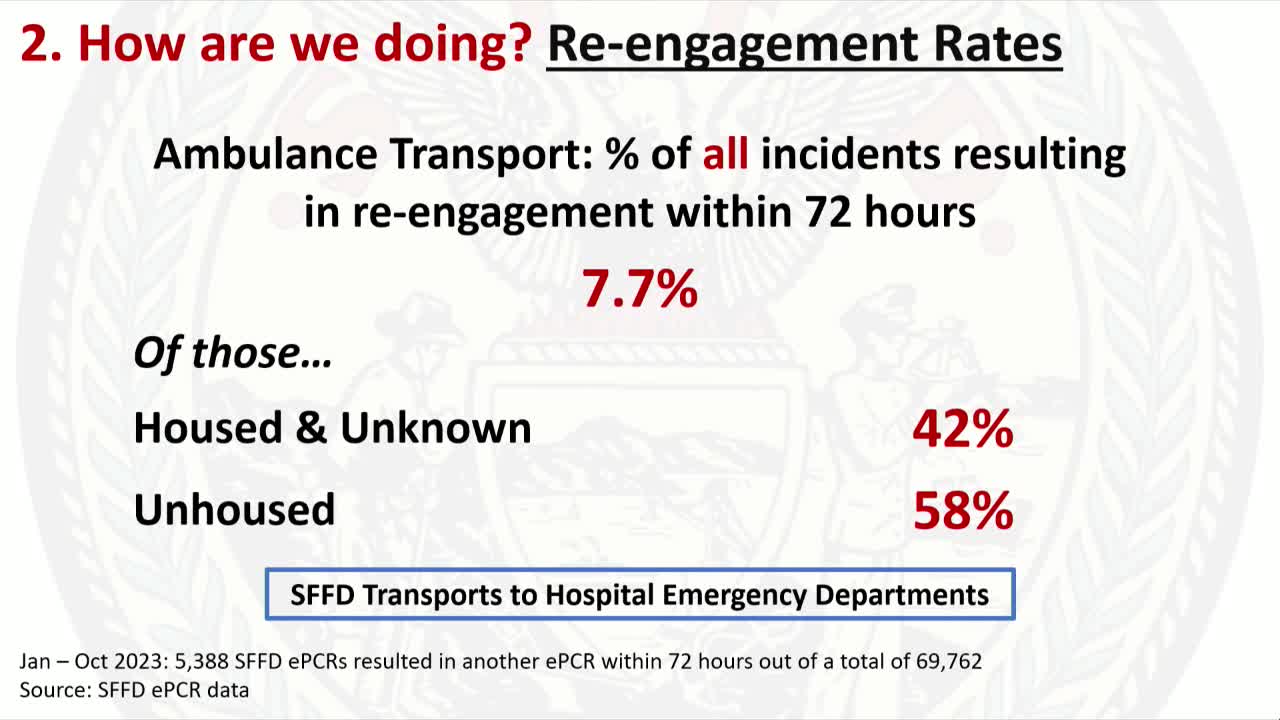San Francisco addresses homelessness with new calls for residential treatment solutions
November 09, 2023 | San Francisco County, California
This article was created by AI summarizing key points discussed. AI makes mistakes, so for full details and context, please refer to the video of the full meeting. Please report any errors so we can fix them. Report an error »

In a recent government meeting focused on addressing homelessness and substance use in San Francisco County, officials discussed critical gaps in the current treatment and support systems for the unhoused population. The meeting highlighted the urgent need for improved residential treatment options and better access to healthcare services for individuals experiencing homelessness.
One of the key points raised was the necessity of providing stable environments for those undergoing treatment for substance use disorders. Experts emphasized that individuals prescribed medications like Suboxone or buprenorphine require a stable living situation—ideally a residential treatment facility—for 30 to 90 days to effectively metabolize their medications and participate in therapeutic sessions. Without this stability, the likelihood of successful recovery diminishes significantly.
Statistics presented during the meeting revealed a stark health inequity: while the unhoused make up approximately 1% of San Francisco's population, they account for 25% of ambulance transports this year. Alarmingly, 58% of those seen within 72 hours of re-engagement were homeless, indicating a pressing need for enhanced care and follow-up services.
The discussion also touched on the challenges faced by treatment providers. Many individuals seeking help encounter barriers such as long wait times and a lack of clear information about available services. The need for increased accessibility to treatment options was underscored, with suggestions for better communication about where and when services are available. The current system often leaves those in need without the necessary guidance to navigate their treatment options.
Moreover, the meeting addressed the importance of creating a more seamless connection between emergency services and treatment facilities. Many individuals discharged from hospitals do not receive adequate follow-up care, which contributes to a revolving door effect where patients return to emergency services without achieving lasting recovery.
Officials proposed several foundational policies to improve conditions for the unhoused, including a zero-tolerance approach to public substance use paired with accessible treatment options. The idea is to establish clear, visible treatment centers that encourage individuals to seek help, thereby reducing the stigma associated with addiction and homelessness.
In conclusion, the meeting highlighted the critical need for systemic changes in how San Francisco addresses homelessness and substance use. By improving access to treatment, enhancing communication about available services, and fostering a supportive environment for recovery, the city aims to create a more effective response to these pressing social issues. The discussions set the stage for future initiatives aimed at reducing homelessness and improving health outcomes for vulnerable populations in the community.
One of the key points raised was the necessity of providing stable environments for those undergoing treatment for substance use disorders. Experts emphasized that individuals prescribed medications like Suboxone or buprenorphine require a stable living situation—ideally a residential treatment facility—for 30 to 90 days to effectively metabolize their medications and participate in therapeutic sessions. Without this stability, the likelihood of successful recovery diminishes significantly.
Statistics presented during the meeting revealed a stark health inequity: while the unhoused make up approximately 1% of San Francisco's population, they account for 25% of ambulance transports this year. Alarmingly, 58% of those seen within 72 hours of re-engagement were homeless, indicating a pressing need for enhanced care and follow-up services.
The discussion also touched on the challenges faced by treatment providers. Many individuals seeking help encounter barriers such as long wait times and a lack of clear information about available services. The need for increased accessibility to treatment options was underscored, with suggestions for better communication about where and when services are available. The current system often leaves those in need without the necessary guidance to navigate their treatment options.
Moreover, the meeting addressed the importance of creating a more seamless connection between emergency services and treatment facilities. Many individuals discharged from hospitals do not receive adequate follow-up care, which contributes to a revolving door effect where patients return to emergency services without achieving lasting recovery.
Officials proposed several foundational policies to improve conditions for the unhoused, including a zero-tolerance approach to public substance use paired with accessible treatment options. The idea is to establish clear, visible treatment centers that encourage individuals to seek help, thereby reducing the stigma associated with addiction and homelessness.
In conclusion, the meeting highlighted the critical need for systemic changes in how San Francisco addresses homelessness and substance use. By improving access to treatment, enhancing communication about available services, and fostering a supportive environment for recovery, the city aims to create a more effective response to these pressing social issues. The discussions set the stage for future initiatives aimed at reducing homelessness and improving health outcomes for vulnerable populations in the community.
Don't Miss a Word: See the Full Meeting!
Go beyond summaries. Unlock every video, transcript, and key insight with a Founder Membership.
✓
Get instant access to full meeting videos
✓
Search and clip any phrase from complete transcripts
✓
Receive AI-powered summaries & custom alerts
✓
Enjoy lifetime, unrestricted access to government data
30-day money-back guarantee

